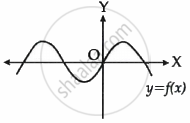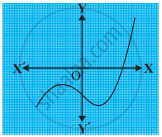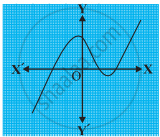Advertisements
Advertisements
Question
The graph of y = f(x) is shown in the figure for some polynomial f(x). The number of zeroes of f(x) are ______.

Options
4
3
2
1
Solution
The graph of y = f(x) is shown in the figure for some polynomial f(x). The number of zeroes of f(x) are 4.

Explanation:
f(x) intersects the x-axis at 4 points.
APPEARS IN
RELATED QUESTIONS
The graphs of y = p(x) are given in following figure, for some polynomials p(x). Find the number of zeroes of p(x).

The graphs of y = p(x) are given in following figure, for some polynomials p(x). Find the number of zeroes of p(x).

The graphs of y = p(x) are given in following figure, for some polynomials p(x). Find the number of zeroes of p(x).

Find all the zeroes of polynomial `(2x^4 – 11x^3 + 7x^2 + 13x – 7)`, it being given that two of its zeroes are `(3 + sqrt2) and (3 – sqrt2)`.
Find the value of k such that the polynomial x2 − (k + 6)x + 2(2k −1) has sum of its zeros equal to half of their product.
10. The zeroes of the quadratic polynomial x² + kx + k, k? 0.
If one of the zeroes of a quadratic polynomial of the form x² + ax + b is the negative of the other, then it ______.
If x3 + 11 is divided by x2 – 3, then the possible degree of remainder is ______.
If one of the zeroes of the cubic polynomial x3 + px² + qx + r is -1, then the product of the other two zeroes is ______.
The graph of y = f(x) is shown in the figure for some polynomial f(x).

The number of zeroes of f(x) is ______.
